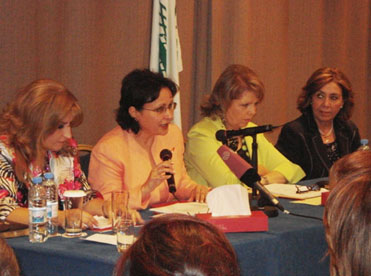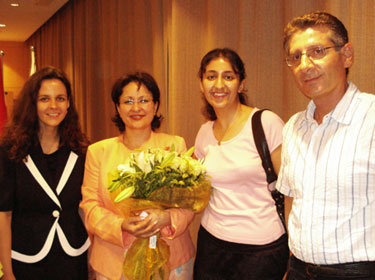LERC participates in a conference entitled Role of the Lebanese Woman in the Diaspora, organized by the Committee of Women of Lebanese Descent in the World Lebanese Cultural Union (WLCU), at Le Royal Hotel, Dbaye
7 August 2008
Reported by Basma Abdul Khalek (LERC Research Assistant)
The World Lebanese Cultural Union (WLCU) organized a conference on the Role of the Lebanese Woman in the Diaspora, in the presence of President Sleiman's representative Ambassador Mr. Khalil Karam, Minister of Tourism representative Ms. Ghada Fakhoury, MP Sethrida Geagea, the World President of WLCU Mr. Elie Hakmeh, and the President of the Committee of Women of Lebanese Descent Ms. Haifa Chedrawi.
Participants in the conference included Dr. Salwa Al Amine, Dr. Soad Al Hakim and LERC Director Ms. Guita Hourani. The conference was moderated by the journalist Mrs. Laure Sleiman Saab.
After the national anthem, Mrs. Saab opened the conference and welcomed the audience. She stated that about fifty thousand Lebanese people migrate from Lebanon each year. That is why the Lebanese woman has a very important role to play regarding the preservation of family cohesion, national traditions and mother tongue.
In her turn, Ms. Chedrawi thanked the audience for attending this event. She also presented the main goals and incentives behind the creation of the Committee. The main objective remains to assemble the Lebanese ladies who left their country for so many reasons, in order to implement a long-term strategy that enhances their role.
Mr. Elie Hakmeh said: “the World Lebanese Cultural Union is not a union just for men, but includes women as well, since they play the principal role for their children and social surroundings. This role consists in teaching the children their mother tongue and keeping the relations with the extended family, which allows them to hold on to the Lebanese social practices and customs.
The session began with Ms. Hourani's talk on the history of Lebanese women’s migration, which started since the nineteenth century. The travel facilities and the will to improve a family’s financial situation have been major factors behind their migration. Firstly, they worked in trade because of their lack in qualification, but some women were competent and skilled enough to act in politics and journalism. Concerning women’s emigration since 1975, Ms. Hourani added that migration trends and features have changed because of the unstable situation of Lebanon. The percentage of women aged between 22 and 44 years who have left the country since then has reached 70%, according to the survey conducted by Saint Joseph’s University between 1975 and 2001. Causes of migration vary greatly, but are mainly related to family reunion, employment, financial difficulties, and security issues. She also lay stress on both the advantage of migration, which is principally the inflow of remittances and a social status guarantee, and the inconvenience related to the brain drain and loss in human resources that benefit only receiving countries. Ms. Hourani stressed the importance of the tendency to migrate among young qualified Lebanese women. She mentioned also the results of the survey conducted by the Lebanese Emigration Research Center after the July 2006 war in Lebanon. 53% of the women interviewed revealed a preference to migrate while 91% of them stated that they would be emigrating for the first time. This she said shows that Lebanese migration has started to involve women with high degrees of qualification, experience, know-how and proficiency.

From left to right: Mrs. Laure Sleiman Saab, Ms. Guita Hourani giving her speech, Dr. Salwa Al Amine, and Dr. Soad Al Hakim. (August 2008)

Ms. Hourani posing with LERC team: Ms. Marinova, Ms. Abdul Khalek and Mr. Elie Nabhan. (August 2008)
Dr. Al Amine then made a speech that focused on the role that Lebanese women are playing to support their partners once away from the country. She also did not exclude the importance of the long-standing Lebanese migration to Latin American countries, to the United States, and to Africa as well as the recent flow of migration towards the Gulf countries, Canada and Australia. Dr. Al Amine finally stressed the values that Lebanese women have managed to maintain in their family life and to combine it with the new societies’ traditions and way of life.
In her note, Dr. Al Hakim brought together migration and women’s liberalization. She considered that feminine migration has added much to Lebanese women’s personalities and social profiles. It has made them to live and experience the divergences that existed between their homeland and the country they migrated to. She highlighted the power that these women have to identify their rights and responsibilities towards host societies which facilitated their integration, without losing their own original Lebanese identity.